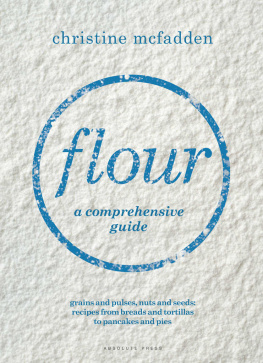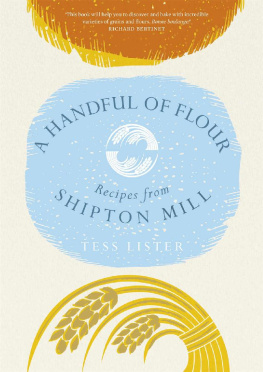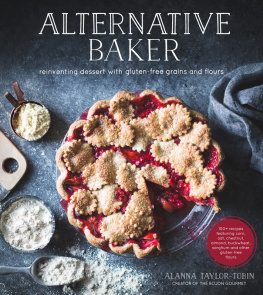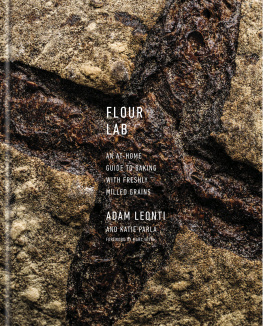
Sincere thanks to my late friend and poet Geoffrey Godbert, and also to food writer Jenny Linford for encouraging me to write this book


introduction
Researching and writing about flour has been an incredibly rewarding challenge. I have spent days deep in a floury haze of what often seemed to be hugely baffling information the difference between flours, starches and meals; what is gluten and how does it make dough rise; what are falling numbers; is there any difference between cereals, grains and seeds? I have learned the meaning of mysterious terms such as naked grains, autolysis and straight and patent flour. I have visited mills thundering scary places where people stride about in steel-capped boots and in doing so I have developed a fascination for paper flour sacks; I love the typography and sturdy white paper. The research has led me down rabbit holes that I didnt know existed the intricacies of flours from Hong Kong and the Czech Republic for example. Whole books could be devoted to them.
I am lucky to live in a remote hamlet in Dorset, one of the UKs most bucolic counties. Arable farming is the norm, and there are plenty of grain fields to investigate, and friendly farmers happy to talk about crops. There are also millers and bakers who have generously shared valuable information. Through talking to these experts I have become much more aware of the natural rhythms of farming, the seasons when grains are sown and harvested, and the skill behind milling and professional baking.
Ferreting out accurate research has sometimes been frustrating. Barely five or six years ago, the term flour implicitly meant ground wheat, and most major reference books didnt mention alternatives. The Cambridge World History of Food, for example, contains lengthy and learned entries on grains, nuts, pulses and starchy roots but doesnt touch on using them as flour. Neither flour nor grains are of consequence to the erudite Waverley Root, a respected authority on food. The flour entry in his hefty volume Food is curiously limited to the flour tree, whose beanlike fruit is fermented and used as a condiment throughout West Africa.
I regularly resorted to perusing food science notes from my university days; I was so pleased I had kept them. Constants throughout were two trusty reference books: On Food and Cooking: The Science and Lore of the Kitchen by science writer Harold McGee, and the late Alan Davidsons enormous tome The Oxford Companion to Food. Both were permanently propped up next to my desk, appropriately in a directors chair, rather like unseen university tutors. Without them I would have been at a loss.
Though I love to cook, I am not a natural baker and I rarely eat sweet foods. Nor do I suffer from gluten sensitivity. Even though steep learning curves were involved as I honed my bread-making skills, learned to like cakes and got to grips with gluten-free dough, devising the recipes was such an enjoyable and satisfying process.
The first day of recipe testing happened to coincide with watching Shrek 2 with my grandchildren. There is a memorable moment when Shrek bellows, Were gonna need flour, lots and lots of flour it brought about a frenzy of air-punching from me and my family. From that moment on, friends started sending me unusual flours, samples from mills arrived in the post and I became a flour junkie. That said, I havent always been so flour fixated. I have childhood memories of a loathsome pot of flour-and-water paste and a bristly brush. I used it to laboriously paste scraps of paper round a light bulb to make a papier-mch head for a doll, and I stuck treasured items into a paper scrapbook. I remember that the damp pages took ages to dry and left the entire scrapbook smelling faintly sour.
In what I call pre-book days, my flours could be easily housed a single tub. Now I have a dedicated spare room lined with shelf after shelf of carefully labelled boxes. This has become the flour library and I love to spend time there, occasionally plunging my hands into a particular flour, enjoying its softness and coolness. The flours have taken on anthropomorphic qualities some seem gentle and accommodating, others need coaxing into submission. Some are pale and anaemic, others are robust and wholesome. Some are a cheerful yellow, others a mysterious blue or sombre grey.
Nowadays we are fortunate in having a cornucopia of flour at our disposal, gluten-free and otherwise, from all over the world, ground not only from grains and seeds but also from pulses, nuts, tubers, roots and even insects. I sometimes wonder if we have reached peak flour now that so many ingredients are ground to a powder and marketed as so-called flour.
Flour has many roles, not just in baking but in weaving its way in and out of other ingredients in so many dishes. As Martial, the sharp-witted Roman, wrote in one of his pithy epigrams, You can list neither the virtues of fine flour, nor all its uses Responding to the challenge, I have made a point of including recipes that demonstrate the many ways in which flour can be used: in pancake batters, coating crisp fried foods, binding burgers and fritters, thickening sauces and stews, fortifying puddings and porridges, and more. The recipes in this book are a motley collection but there is something for everyone, including non-bakers. I hope you enjoy them.
Christine McFadden
October 2017
how to use this book
The forty-five flours in this book are listed in sequential AZ format. This makes it easy to look up a flour that interests you rather than having to decide on a category in which it might be included. You will therefore find gluten-free flours listed with gluten-containing flours, flours from seeds listed with flours from nuts or tubers, and so on.
Each flour entry begins with a CV stating its source, Latin name, gluten and/or protein content, plus suggestions on ingredients or flavours that make good culinary partners, and ways in which it can be used.
The CV is followed by an in-depth description of the flour, including a brief historical or geographical background, interesting anecdotes, how its produced, growing conditions, recipe suggestions, nutritional information, tips for the cook and where you can buy it. Following the description are one or more fully tested recipes showing good ways of using it.
Dispersed throughout the book are essays on flour-related topics. These include a simplification of the hard-core science of gluten, protein and resistant starch, an overview of wheat, a discussion of milling and a description of stone grinding at a traditional working watermill.
flour notes
With a cornucopia of alternative flours ground not only from grains but also from nuts, roots and pulses, there is a need for information about how to use, prepare and store them. Throughout the book youll find this covered in detailed descriptions of each flour, but here are some basics.
Storing
All flours lose their flavour and nutrients over time, but they will last longer if properly stored.
Buy only what you can use before it expires.
Check the use by date from time to time and throw out flour that is past its best.
Dont add new flour to old.
If not using quickly, decant an open packet into a sealed container.
Next page








